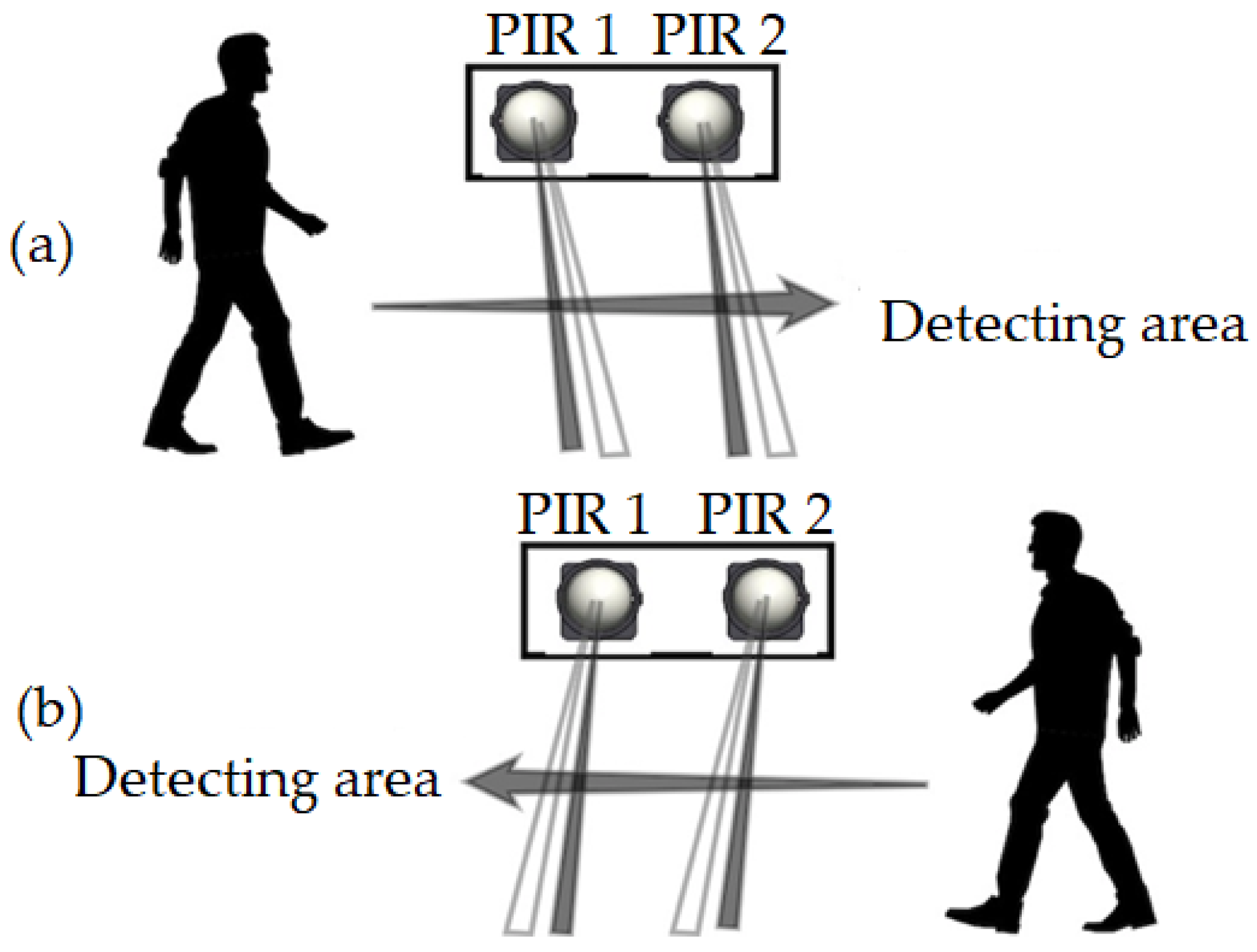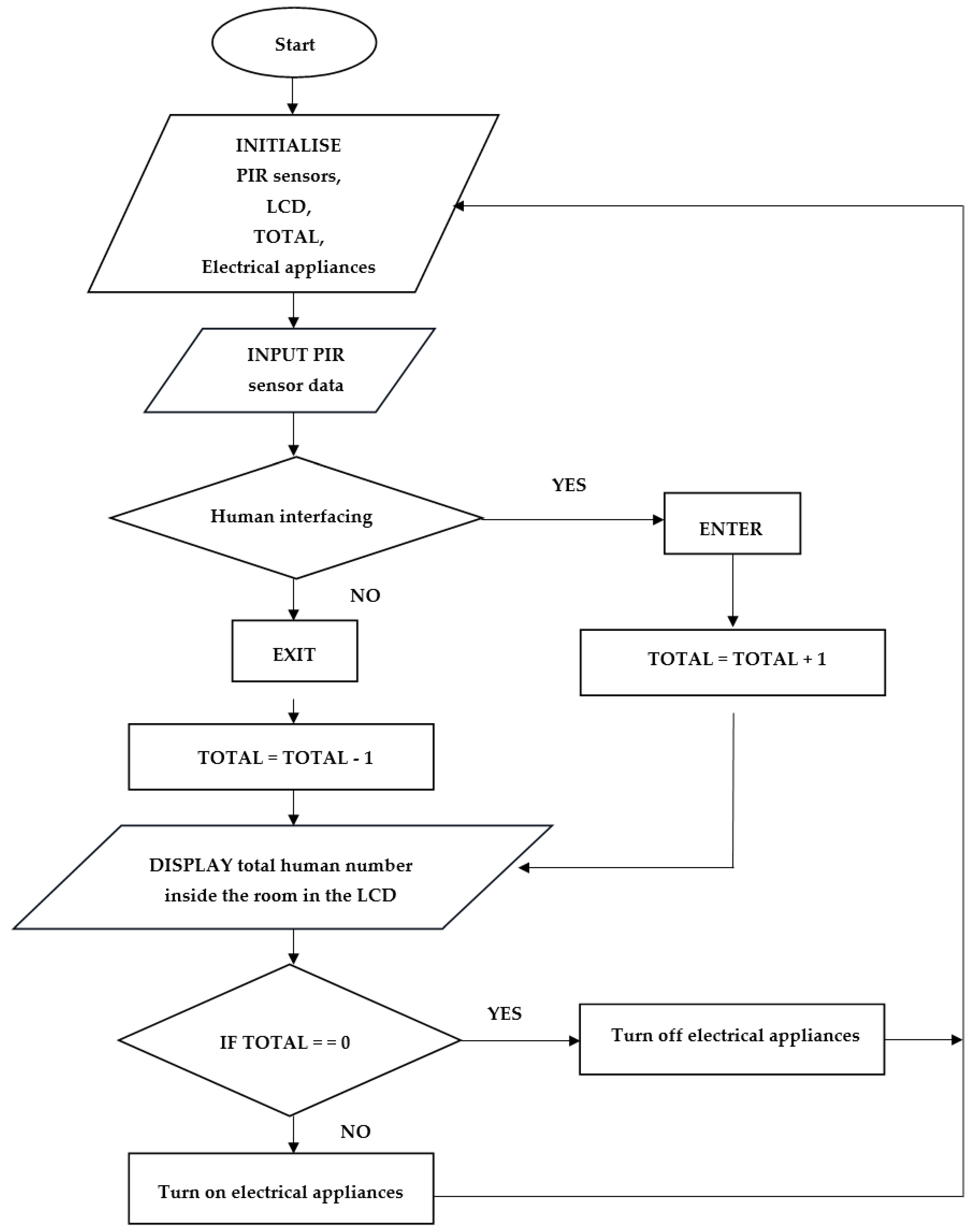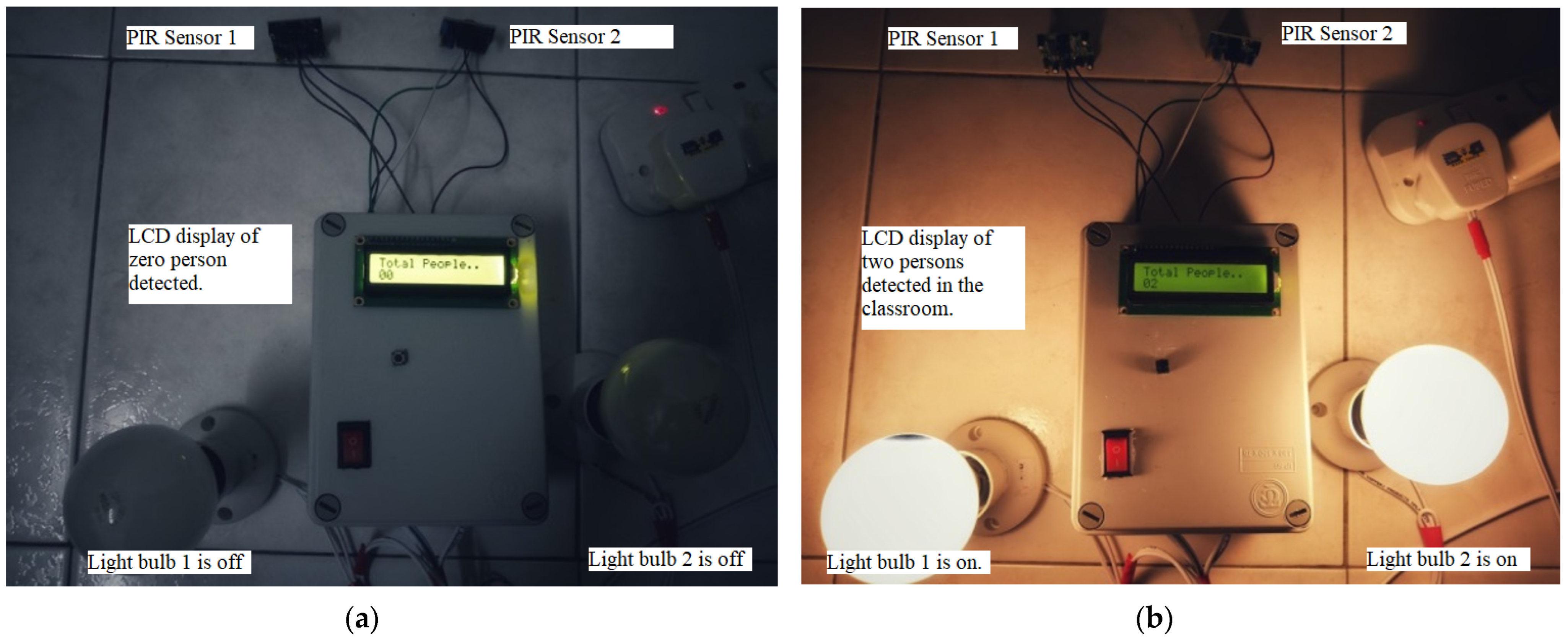A TRIZ Approach for Designing a Smart Lighting and Control System for Classrooms Based on Counter Application with Dual PIR Sensors
Abstract
1. Introduction
1.1. Research Contribution
1.2. Paper Organization
2. Literature Review
- Articulation of the engineering contradiction.
- Determination of system parameters pertinent to the engineering contradiction.
- Overlapping of system parameters within the TRIZ contradiction matrix.
- Adoption of an inventive principle derived from the intersection of system parameters.
- Generation of a solution based on the chosen inventive principle.
3. Materials and Methods
3.1. The Theory of Inventive Problem Solving (TRIZ) Applied
3.2. Proposed Prototype
3.2.1. Power Supply Module
3.2.2. Counter Module
3.2.3. Switch Module
3.2.4. Operation Flowchart for the Algorithm
4. Result and Discussion
4.1. Power Supply Module Discussion
4.2. Testing and Validation of the System Functionality
4.3. Power Consumption of the System
5. Limitations and Prospects
6. Conclusions
Author Contributions
Funding
Institutional Review Board Statement
Informed Consent Statement
Data Availability Statement
Acknowledgments
Conflicts of Interest
References
- Prepared for the Buildings Technologies Program, Energy Efficiency and Renewable Energy. 2011 Buildings Energy Data Book (U.S. Department of Energy). Available online: https://ieer.org/resource/energy-issues/2011-buildings-energy-data-book/ (accessed on 25 November 2023).
- Frequently Asked Questions (Faqs)—U.S. Energy Information Administration (EIA). Available online: https://www.eia.gov/tools/faqs/faq.php?id=99&t=3 (accessed on 20 December 2023).
- U.S. Energy Information Administration-EIA-Independent Statistics and Analysis. Available online: https://www.eia.gov/energyexplained/use-of-energy/commercial-buildings.php (accessed on 28 April 2023).
- Suresh, S.; Anusha, H.N.S.; Rajath, T.; Soundarya, P.; Vudatha, S.V.P. Automatic Lighting and Control System for Classroom. In Proceedings of the 2016 International Conference on ICT in Business Industry & Government (ICTBIG), Indore, India, 18–19 November 2016. [Google Scholar] [CrossRef]
- Torabi, M.; Mahdavinejad, M. Past and Future Trends on the Effects of Occupant Behaviour on Building Energy Consumption. J. Sustain. Archit. Civ. Eng. 2021, 29, 83–101. [Google Scholar] [CrossRef]
- Transforming the Market: Energy Efficiency in Buildings. Available online: https://www.wbcsd.org/Programs/Cities-and-Mobility/Resources/Transforming-the-Market-Energy-Efficiency-in-Buildings (accessed on 28 April 2023).
- Keller, H. 30 Years of Passive Infrared Motion Detectors—A Technology Review. Available online: https://jvs.de/Carclo_Fresnel/pdf_content/2000-05_irs2paper_Hans_j_Keller.pdf (accessed on 8 August 2021).
- Guo, X.; Tiller, D.; Henze, G.; Waters, C. The Performance of Occupancy-Based Lighting Control Systems: A Review. Light. Res. Technol. 2010, 42, 415–431. [Google Scholar] [CrossRef]
- Chong, P.L.; Ganesan, S.; Than, Y.Y.; Ravi, P. Designing an Autonomous Triggering Control System via Motion Detection for IOT Based Smart Home Surveillance CCTV Camera. Malays. J. Sci. Adv. Technol. 2023, 2, 80–88. [Google Scholar] [CrossRef]
- Chong, P.L.; Than, Y.Y.; Ganesan, S.; Ravi, P. An Overview of IOT Based Smart Home Surveillance and Control System: Challenges and Prospects. Malays. J. Sci. Adv. Technol. 2023, 2, 54–66. [Google Scholar] [CrossRef]
- Wan Mat, W.N.; Suriza, A.Z. Implementation of Green Technology System in a Classroom. In Proceedings of the 2018 7th International Conference on Computer and Communication Engineering (ICCCE), Kuala Lumpur, Malaysia, 19–20 September 2018. [Google Scholar] [CrossRef]
- Lai, K.-C.; Ku, B.-H.; Wen, C.-Y. Using Cooperative Pir Sensing for Human Indoor Localization. In Proceedings of the 2018 27th Wireless and Optical Communication Conference (WOCC), Hualien, Taiwan, 30 April–1 May 2018. [Google Scholar] [CrossRef]
- Chowdhury, A.; Tripathy, S.S. Detection of Human Presence in a Surveillance Video Using Fuzzy Approach. In Proceedings of the 2014 International Conference on Signal Processing and Integrated Networks (SPIN), Noida, India, 20–21 February 2014. [Google Scholar] [CrossRef]
- Joshi, D.; Purwar, A.; Dasgupta, M.S. Human Detection Based on Explicit Skin Colour Space Thresholding and Minor Motion Detection. In Proceedings of the 2014 Annual IEEE India Conference (INDICON), Pune, India, 11–13 December 2014. [Google Scholar] [CrossRef]
- Asakipaam, S.A.; Mensah, A.; Boateng, C.O. Smart Energy Conservation System for Study Rooms. IAES Int. J. Robot. Autom. 2022, 11, 223. [Google Scholar] [CrossRef]
- Nazidizaji, S.; Tome, A.; Regateiro, F. Investigation about the Feasibility and Impediments of TRIZ Application in Architectural Design Process. Procedia Eng. 2015, 131, 651–660. [Google Scholar] [CrossRef]
- Zulhasni, A.R.; Nooh, A.B. Innovative Cases of TRIZ Application in the Automotive Industry. Appl. Mech. Mater. 2015, 735, 326–330. [Google Scholar] [CrossRef]
- Wang, F.-K.; Chen, K.-S. Applying Lean Six Sigma and TRIZ Methodology in Banking Services. Total Qual. Manag. Bus. Excell. 2010, 21, 301–315. [Google Scholar] [CrossRef]
- Renev, I.A.; Chechurin, L.S. Application of TRIZ in Building Industry: Study of Current Situation. Procedia CIRP 2016, 39, 209–215. [Google Scholar] [CrossRef]
- Ng, P.K.; Chong, P.L.; Yeow, J.A.; Ng, Y.J.; Robert, J.N. Ergonomic Work from Home Recommendations Using TRIZ “Stop Robbing Peter to Pay Paul”. In Human Factors in Engineering: Manufacturing Systems, Automation, and Interactions; Mrugalska, B., Ahram, T.Z., Karwowski, W., Eds.; CRC Press: Boca Raton, FL, USA, 2023; pp. 65–82. Available online: https://www.taylorfrancis.com/books/edit/10.1201/9781003383444/human-factors-engineering-tareq-ahram-waldemar-karwowski-beata-mrugalska?refId=96307a0a-c4d3-4074-b416-9d824d6f246f&context=ubx (accessed on 28 April 2023).
- Chong, P.L.; Ganesan, S.; Ng, P.K.; Kong, F.Y. A TRIZ-Adopted Development of a Compact Experimental Board for the Teaching and Learning of Operational Amplifier with Multiple Circuit Configurations. Sustainability 2022, 14, 14115. [Google Scholar] [CrossRef]
- Kang, C.Q.; Ng, P.K.; Liew, K.W. A TRIZ-Integrated Conceptual Design Process of a Smart Lawnmower for Uneven Grassland. Agronomy 2022, 12, 2728. [Google Scholar] [CrossRef]
- Tan, R.E.; Ng, P.K.; Tan, D.W.; Lim, W.S. A TRIZ-Directed Approach in Proposing Device-Oriented Ideas That Cultivate Water-Drinking Habits among Children. Cogent Eng. 2021, 8, 1868134. [Google Scholar] [CrossRef]
- Lim, I.S.S.; Chung, E.C.Y.; Tan, K.B.T.; Teoh, K.S. The Practicality of TRIZ Based Conceptual Solutions in Solving Tombstoning Defects during SMD Soldering. Chem. Eng. Res. Des. 2015, 103, 123–129. [Google Scholar] [CrossRef]
- Ng, P.K.; Prasetio, M.D.; Liew, K.W.; Lim, B.K.; Oktafiani, A.; Salma, S.A.; Safrudin, Y.N. A TRIZ-Inspired Conceptual Development of a Roof Tile Transportation and Inspection System. Buildings 2022, 12, 1456. [Google Scholar] [CrossRef]
- Roslizar, A.; Alghoul, M.A.; Bakhtyar, B.; Asim, N.; Sopian, K. Annual Energy Usage Reduction and Cost Savings of a School: End-Use Energy Analysis. Sci. World J. 2014, 2014, 310539. [Google Scholar] [CrossRef] [PubMed]
- Gul, M.S.; Patidar, S. Understanding the Energy Consumption and Occupancy of a Multi-Purpose Academic Building. Energy Build. 2015, 87, 155–165. [Google Scholar] [CrossRef]
- Karpudewan, M.; Ponniah, J.; Md. Zain, A.N. Project-Based Learning: An Approach to Promote Energy Literacy among Secondary School Students. Asia-Pac. Educ. Res. 2015, 25, 229–237. [Google Scholar] [CrossRef]
- Twumasi, E.; Frimpong, E.A.; Kemausuor, F.; Appiah, D.O.; Okyere, P.Y. Energy Efficiency Awareness and Preparedness among Students. In Proceedings of the 2017 IEEE PES PowerAfrica, Accra, Ghana, 27–30 June 2017. [Google Scholar] [CrossRef]
- Mathis, W.J. Financial Challenges, Adequacy, and Equity in Rural Schools and Communities. J. Educ. Financ. 2003, 29, 119–136. [Google Scholar]
- Desai, P.; Modi, N. Problems with PIR Sensors in Smart Lighting+Security Solution and Solutions of Problems. In Smart Innovation, Systems and Technologies; Springer: Berlin/Heidelberg, Germany, 2019; pp. 481–486. [Google Scholar] [CrossRef]
- Available online: https://www.microchip.com/en-us/product/AT89S51 (accessed on 19 December 2023).
- Chong, P.L.; Singh, A.K.; Kok, S.L. Potential Application of Aloe Vera-Derived Plant-Based Cell in Powering Wireless Device for Remote Sensor Activation. PLoS ONE 2019, 14, e0227153. [Google Scholar] [CrossRef]
- Chong, P.L.; Singh, A.K.; Kyong, F.Y. Renewable Energy from Living Plants to Power IoT Sensor for Remote Sensing. ADBU J. Eng. Technol. 2022, 11. Available online: https://journals.dbuniversity.ac.in/ojs/index.php/AJET/article/view/3613 (accessed on 19 December 2023).
- Al-badani, M.A.; Chong, P.L.; Lim, H.S. Enhancing Microbial Fuel Cell Performance with Carbon Powder Electrode Modifications for Low-Power Sensors Modules. Int. J. Renew. Energy Dev. 2023, 13, 80–87. [Google Scholar] [CrossRef]











| No. | Method Employed | Key Features | Significant Contributions | Limitations | Utilization of PIR Sensor | Dependence on Constant Movement of User for Operation | References |
|---|---|---|---|---|---|---|---|
| 1 | An autonomous lighting control system that detects the presence of humans and controls the intensity of the lamp. | Usage of a light sensor, a passive infrared (PIR), and an infrared (IR) sensor to detect the presence of human. | The system can measure and analyze the brightness of light according to the surrounding exposure and provides easy installation. | Depends on detection of continuous movement of people in the classroom for continuous control of light intensity. | Yes | Yes | [11] |
| 2 | Application of pyroelectric infrared sensors to be embedded into a non-terminal indoor localization system mounted on the ceiling to increase the precision in estimating the location of a target inside a room. | Usage of a PIR detection module (PDM) system made of two PIR modules to collect infrared signals for human sensing and estimation of the person’s location in a room. | The proposed system with 2 PIR modules achieves simplified system design and better estimation accuracy. | Depends on detection of continuous movement of people in the room for estimation of the target location. | Yes | Yes | [12] |
| 3 | Application of fuzzy logic algorithms to analyze video data to identify human presence. | Detect human presence in surveillance video by extracting the variety of human skin color with a fuzzy approach from the selected video frame. | The approach suggested improves the effectiveness of human detection in a video. | Depends on CCTV video frame data only which is not applicable for a conventional classroom without any CCTV installation. | No | No | [13] |
| 4 | Application of explicit skin color space thresholding and minor motion detection techniques to accurately detect human presence in visual data. | Implement skin color detection by using explicit thresholding of CbCr color channels and usage of morphological differences of multiple consecutive images for minor motion detection | The approach is efficient in detecting human presence based on skin color and motion in frame of video as well as identifying the location of the human within the frame. | Depends on CCTV video frame data only which is not applicable for a conventional classroom without any CCTV installation | No | No | [14] |
| 5 | Regulation of lighting based on the presence of humans using relay control and mobility. | Employs an infrared remote-control mechanism to switch on or off an energy system in the absence of humans | The research produces a low cost, portable microcontroller-based automated room light controller applicable for energy waste management. | The prototype experiences a limited range for sensing objects/people. | No | No | [15] |
| 6 | Application of an Arduino-based automatic lighting and control system connected to relay control to detect human presence with coupling to Android mobile app and Bluetooth control to enable control of the lighting with voice command. | The research proposed the division of the classroom into grids to control lighting in particular areas of the classroom based on the presence of human. | An automatic lighting control system is developed which can detect human location in its grid for switching appliances on or off. | The prototype with additional features proposed can incur a higher cost of fabrication. | No | No | [4] |
| 7 | Application of counter system with dual PIR sensors to enable smart lighting and control system for classroom. | Usage of two PIR sensors and counter to automatically count the amount of people in the classroom without dependence on continuous human motion detection. | Explained in 1.1 Research Contribution. | Explained in 5. Limitations and Prospects. | Yes | No | Current proposed method |
| No. | System Parameter | No. | System Parameter |
|---|---|---|---|
| 1 | Weight of Moving Object | 21 | Power |
| 2 | Weight of Stationary Object | 22 | Loss of Energy |
| 3 | Length of Moving Object | 23 | Loss of Substance |
| 4 | Length of Stationary Object | 24 | Loss of Information |
| 5 | Area of Moving Object | 25 | Loss of Time |
| 6 | Area of Stationary Object | 26 | Quantity of Substance |
| 7 | The Volume of the Moving Object | 27 | Reliability |
| 8 | The Volume of the Stationary Object | 28 | Measurement Accuracy |
| 9 | Speed | 29 | Manufacturing Precision |
| 10 | Force | 30 | Object Affected Harmful Factors |
| 11 | Pressure or Stress | 31 | Object-Generated Harmful Factors |
| 12 | Shape | 32 | Manufacturability |
| 13 | Stability of the Object’s Composition | 33 | Ease of Operation |
| 14 | Strength | 34 | Repairability |
| 15 | Duration of Action of Moving Object | 35 | Adaptability or Versatility |
| 16 | Duration of Action of Stationary Object | 36 | Device Complexity |
| 17 | Temperature | 37 | Difficulty in Detecting and Measuring |
| 18 | Illumination Intensity | 38 | Extent of Automation |
| 19 | Use of Energy by Moving Object | 39 | Productivity |
| 20 | Use of Energy by Stationary Object |
| Details | EC1 | EC2 |
|---|---|---|
| “then” part (with system parameter) | then such electricity wastage caused by the students who do not switch off the lighting before exiting the classroom should be avoided (SP #6 Area of stationary object) | then such a system must be modified from the existing system to avoid huge changes incurring additional costs (SP #33 Ease of operation) |
| “but” part (with system parameter, SP) | but this required an intelligent autonomous system to control the switching of the lighting based on human presence detection to avoid dependency on human manual control (SP #38 Extent of Automation) | but the current cheap system is mostly designed with conventional PIR sensors which depend on constant human motion to enable continuous triggering of lighting (SP #15 Duration of action of moving object) |
| Inventive principle (IV) | IV #23: Feedback | IV #29: Pneumatics and Hydraulics IV #3: Local quality IV #8: Anti-weight IV #25: Self-service |
| Selected | IV #23: Feedback | IV #25: Self-service |
| Condition | Total Number | Effect |
|---|---|---|
| Initial | 00 | 2 Light Bulbs are OFF |
| Entrance | 01 | ON two light bulbs |
| Entrance | 02 | ON two light bulbs |
| Exit | 01 | ON two light bulbs |
| Exit | 00 | OFF two light bulbs |
| Components | Voltage (V) | Current (mA) | Power (mW) |
|---|---|---|---|
| AT89S51 Microcontroller | 5 | 25 | 50 |
| 2 PIR Sensors | 5 | 0.1 | 0.5 |
| 2 Channel relay driver | 5 | 72 | 360 |
| LCD | 5 | 16 | 80 |
| Total power: 490.5 |
Disclaimer/Publisher’s Note: The statements, opinions and data contained in all publications are solely those of the individual author(s) and contributor(s) and not of MDPI and/or the editor(s). MDPI and/or the editor(s) disclaim responsibility for any injury to people or property resulting from any ideas, methods, instructions or products referred to in the content. |
© 2024 by the authors. Licensee MDPI, Basel, Switzerland. This article is an open access article distributed under the terms and conditions of the Creative Commons Attribution (CC BY) license (https://creativecommons.org/licenses/by/4.0/).
Share and Cite
Chong, P.L.; Ismail, D.; Ng, P.K.; Kong, F.Y.; Basir Khan, M.R.; Thirugnanam, S. A TRIZ Approach for Designing a Smart Lighting and Control System for Classrooms Based on Counter Application with Dual PIR Sensors. Sensors 2024, 24, 1177. https://doi.org/10.3390/s24041177
Chong PL, Ismail D, Ng PK, Kong FY, Basir Khan MR, Thirugnanam S. A TRIZ Approach for Designing a Smart Lighting and Control System for Classrooms Based on Counter Application with Dual PIR Sensors. Sensors. 2024; 24(4):1177. https://doi.org/10.3390/s24041177
Chicago/Turabian StyleChong, Peng Lean, Daniel Ismail, Poh Kiat Ng, Feng Yuan Kong, Mohammed Reyasudin Basir Khan, and Sargunam Thirugnanam. 2024. "A TRIZ Approach for Designing a Smart Lighting and Control System for Classrooms Based on Counter Application with Dual PIR Sensors" Sensors 24, no. 4: 1177. https://doi.org/10.3390/s24041177
APA StyleChong, P. L., Ismail, D., Ng, P. K., Kong, F. Y., Basir Khan, M. R., & Thirugnanam, S. (2024). A TRIZ Approach for Designing a Smart Lighting and Control System for Classrooms Based on Counter Application with Dual PIR Sensors. Sensors, 24(4), 1177. https://doi.org/10.3390/s24041177










